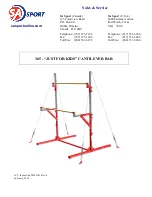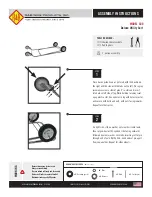
5
yourself skating. In order to turn right you need to shift your centre of gravity first to the inner edge of your
left foot and outer edge of your right foot. Then turn your hip and toes to the right while keeping your legs
locked and shoulders parallel to the ground. Let the momentum carry you until you stop. You can assist
the turn by placing your hands in the direction you intend to turn. Exaggerated movements and a twisted
upper body can lead to a loss of balance.
BRAKING USING THE BRAKES
(VISUAL INSTRUCTION 3)
Braking is the most important skill in inline skating and should be mastered at all costs. Adapt your speed
to your abilities and skate with foresight. Avoid steep terrain until you have completely mastered skating
and braking on flat terrain. On flat ground, beginners can stop by gliding until their momentum subsides.
Use your arms to maintain balance. More advanced skaters brake with the so-called “heel stop” tech-
nique. Here you should adopt the skating position as described above. Then push your braking skate for-
wards and lift your toes upwards a little, while simultaneously pushing down on the brake stopper. Place
about 40% of your body weight on your front skate and 60% on your back skate. This method will bring
you down to a more manageable speed and eventually to a stand-still.
BRAKING WITHOUT USING THE BRAKES
If you are not equipped with brakes then you will need to use the so-called “T-stop” technique. Adopt
the skating position. Place your braking leg to the back and place the skate’s wheels in a 75-80-degree
angle to your direction of motion, letting them drag along on the ground. Now put a little pressure on the
wheels in order to reach a manageable speed and come to a stand-still. The upper body should remain
upright, the shoulders straight. Avoid twisting your body as this may lead you to lose your balance.
MAINTENANCE AND CARE
Regular maintenance and care will increase your skates’ life expectancy and make sure you have more
fun with them.
Rotating the order of wheels
(Visual instruction 4, 5)
Because wheels get worn differently and more on one side than the other, they should be switched regu
-
larly. Follow the illustrated instructions.
Axles
(Visual instruction 7)
Wheels & Spacer
(Visual instruction 8)
To remove Wheels
•
Unscrew with allen key
•
Remove axle
To Asssemble Wheels
•
Re-insert axle
•
Re-tighten axle with allen key.
Maintenance of Bearings
(Visual instruction 9)
Size Adjustment
(Visual instruction 10)
SKATE MAINTENANCE
BEFORE EVERY SKATE
check axels
check all wheels spin freely
AFTER EVERY SKATE
check axles
EVERY WEEK
check mounting bolts
check frame/boot position
check bearings for any unusual noises, lubricate if necessary
check fixation, screws of buckles, straps and cuff screws
Summary of Contents for PHEME Dark Nigh
Page 1: ...1 INSTRUCTION MANUAL EN 13843 2009 Class B 20 60kg ...
Page 3: ...3 1 2 7 8 3 4 9 10 ...
Page 75: ...75 ...






































